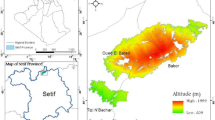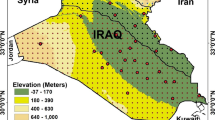Abstract
The estimation of surface evapotranspiration (ET) with satellite dataset is one of the main subjects in the understanding of climate change, disaster monitoring and the circulation of water vapor and energy in Tibet Autonomous Region (TAR). This research selects satellite images on January 11, April 6, July 31 and October 19 in 2010 as the representative of winter, spring, summer and autumn respectively, estimates the distribution of daily surface ET based on the surface energy balance system (SEBS) along with potential evapotranspiration (PET) and ET derived from Penman-Monteith (P-M) method. The results are obtained as follows. (1) The seasonal distribution of ET and PET basically decreases from the southeast part to the northwest part of TAR. Although ET and PET have similar spatial distributions, there are still some differences to estimate the extreme values especially the maximum value in the middle and southeastern parts of TAR. No matter what kind of methods we adopted, the maximum value of ET and PET always appears in summer, followed by autumn or spring while that in winter is the smallest. (2) In order to better understand the accuracy of SEBS model in the estimation of ET, we compared the ET from SEBS and the ET obtained from P-M method. Results show that the ET from SEBS could estimates the variation trend of actual ET, but it slightly underestimates or overestimates the value of ET as a whole, especially for those areas with thick forest. (3) The spatial distribution of Normalized Difference Vegetation Index (NDVI) exhibits a decreasing trend from the southeast part to the northwest part of TAR which displays remarkable consistency of distributions between ET and vegetation index. ET is well positively related to NDVI, minimum, mean, maximum air temperature and sunshine duration in different seasons while negatively related to precipitation, relative humidity and wind speed in summer.
Similar content being viewed by others
References
Chen Xuelong, Su Zhongbo, Ma Yaoming et al., 2013: An improvement of roughness height parameterization of the Surface Energy Balance System (SEBS) over the Tibetan Plateau. J. Appl. Meteor. Climatol., 52: 607–622.
Cui Xudong, Tao Zhengpin, Zhang Jun et al., 2011. Regional evapotranspiration calculation using SEBS method and its reliability analysis: A case study of Hailiutu River in Ordos Plateau. Survey of Science and Technology, 6: 10–12. (in Chinese)
Elhag Mohamed, Psilovikos Aris, Manakos Ioannis et al., 2011. Application of the SEBS water balance model in estimating daily evapotranspiration and evaporative fraction from remote sensing data over the Nile Delta. Water Resources Management, 25(11): 2731–2742.
Jia Zhenzhen, Liu Shamin, Mao Defa et al., 2010. A study of the validation method of remotely sensed evapotranspiration based on observation data. Advances in earth Science, 25(11): 1248–1260. (in Chinese)
Jiang L, Islam S, 1999. A methodology for estimation of surface evapotranspiration over large areas using remote sensing observations. Geophysical Research Letters, 26(17): 2773–2776.
La Ba, Chu Duo, Deji Yangzong, 2012. Study on evapotranspiration in northern Tibet based on SEBS model. Remote Sensing Technology and Application, 27(6): 919–926. (in Chinese)
Li Jia, Su Zhongbo, Bart van den Hurk et al., 2003. Estimation of sensible heat flux using the Surface Energy Balance System (SEBS) and ATSR measurements. Physics and Chemistry of the Earth, 28: 75–88.
Liang S, 2001. Narrowband to broadband conversions of land surface albedo: I. Algorithms. Remote Sensing of Environment, 76(2): 213–238.
Liang S, Chad J S et al., 2003. Narrowband to broadband conversions of land surface albedo: II. Validation. Remote Sensing of Environment, 84(1): 25–41.
Lin Wenjing, Su Zhongbo, Dong Hua et al., 2008. Regional evapotranspiration estimation based on MODIS products and Surface Energy Balance System (SEBS) in Hebei plain, northeastern China. Journal of Remote Sensing, 12(4): 663–672.
Liu Changming, Zhang Dan, Liu Xiaomang et al., 2012. Spatial and temporal change in the potential evapotranspiration sensitivity to meteorological factors in China (1960–2007). Journal of Geographical Sciences, 22(1): 3–14.
Ma Weiqiang, Mohsin Hafeez, Hirohiko Ishikawa et al., 2012. Evaluation of SEBS for estimation of actual evapotranspiration using ASTER satellite data for irrigation areas of Australia. Theoretical and Applied Climatology, doi: 10.1007/s00704-012-0754-3.
Ma Xuening, Zhang Mingjun, Li Yaju et al., 2012. Decreasing potential evapotranspiration in the Huanghe River watershed in climate warming during 1960–2010. Journal of Geographical Sciences, 22(6): 977–988.
Raghuveer K Vinukollu, Eric F Wood et al., 2011. Global estimates of vapotranspiration for climate studies using multi-sensor remote sensing data: Evaluation of three process-based approaches. Remote Sensing of Environment, 115: 801–823.
Sobrino J A, Raissoini N, 2003. Surface temperature and water vapour retrieval from MODIS data. International Journal of Remote Sensing, 24(24): 5161–5182.
Su Z, 2000. Remote sensing of land use and vegetation for mesoscale hydrological studies. International Journal of Remote Sensing, 21: 213–233.
Su Z, 2002. The Surface Energy Balance System (SEBS) for estimation of turbulent heat fluxes. Hydrology and Earth System Sciences, 6(1): 85–89.
Walter I A, Allen R G, Elliot T R et al., 2000. ASCE’s standardized referenced evapotranspiration equation. In: Evans R L. Proceeding of the 4th Decennial Symposium, National Irrigation Symposium. Michigan: American Society of Civil Engineers, 1–6.
Wang Wantong, Qian Lexiang, 2012. Spatial distribution and seasonal variation of evapotranspiration in Yiluo River Basin based on MODIS Data. Resources Science, 34(8): 1582–1590. (in Chinese)
Xi Ge, Liu Shaomin, Jia Li, 2008. Estimation of regional evapotranspiration and ecological water requirement of vegetation by remote sensing in the Yellow River Delta wetland. Acta Ecologica Sinica, 28(11): 5356–5369. (in Chinese)
Yang Yong, Chen Rensheng, Song Yaoxuan et al., 2013. Measurement and estimation of grassland evapotranspiration in a mountainous region at the upper reach of Heihe River Basin, China. Chinese Journal of Applied Ecology, 24(4): 1055–1062. (in Chinese)
Yuichiro O, Hirohiko I, Su Zhongbo, 2007. Estimation of land surface heat fluxes over the Tibetan Plateau using GMS data. J. Appl. Meteor. Climatol., 46: 183–195.
Zhang Shouhong, Liu Suxia, Mo Xingguo et al., 2011. Assessing the impact of climate change on potential evapotranspiration in Aksu River Basin. Journal of Geographical Sciences, 21(4): 609–620.
Zhong Lei, Ma Yaoming, Ma Weiqiang et al., 2011. Land surface heat fluxes in the middle reaches of Yarlung Zangbo River and its two tributaries derived from AVHRR and MODIS data. Journal of Glaciology and Geocryology, 33(2): 309–317. (in Chinese)
Zhu Guofeng, He Yuanqing, Du Tao et al., 2012. Spatial distribution and temporal trends in potential evapotranspiration over Hengduan Mountains regions from 1960 to 2009. Journal of Geographical Sciences, 22(1): 71–85.
Zuo Dakang, Wang Yixian, Chen Jiansui, 1993. Spatial distribution characteristics of solar radiation in China. In: Zuo Dakang’s Geographical Research Papers. Beijing: Science Press, 168–185. (in Chinese)
Author information
Authors and Affiliations
Corresponding author
Additional information
Foundation: National Natural Science Foundation of China, No.41130960; No.41165011; Public Project of Meteorology, No.GYHY201006054; Major projects in Gansu Province, No.1001JKDA001; Project of the China Meteorological Administration, No.CMAGJ2013M51
Rights and permissions
About this article
Cite this article
Zhuo, G., La, B., Pubu, C. et al. Study on daily surface evapotranspiration with SEBS in Tibet Autonomous Region. J. Geogr. Sci. 24, 113–128 (2014). https://doi.org/10.1007/s11442-014-1076-4
Received:
Accepted:
Published:
Issue Date:
DOI: https://doi.org/10.1007/s11442-014-1076-4




